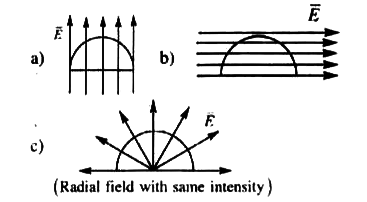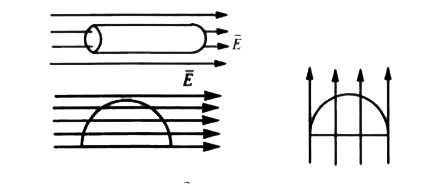A Gaussian surface in the cylinder of cross-section πa2 and length L is immersed in a uniform electric field E with the cylinder axis parallel to the field. The flux ϕ of the electric field through the closed surface is
(a) 2πa2E
(b) πa2EL
(c) πa2(2+L)E
(d) zero
The correct Answer is:D
To find the electric flux Φ through a closed cylindrical Gaussian surface immersed in a uniform electric field E, we can follow these steps:
Step 1: Understand the Geometry
The cylindrical Gaussian surface has a cross-sectional area A=πa2 and length L. The electric field E is uniform and directed parallel to the axis of the cylinder.
Step 2: Identify the Surfaces
The closed surface of the cylinder consists of:
- Two circular ends (cross-sections)
- A curved lateral surface
Step 3: Analyze the Flux Through Each Surface
1. Curved Surface: The electric field is parallel to the axis of the cylinder, while the area vectors of the curved surface are perpendicular to the electric field. Therefore, the flux through the curved surface is zero:
Φcurved=0
2. End Surface 1: For one circular end (let's call it end 1), the area vector is directed opposite to the electric field. The angle between the electric field vector and the area vector is 180∘:
Φ1=−E⋅A=−E⋅(πa2)
3. End Surface 2: For the other circular end (end 2), the area vector is in the same direction as the electric field. The angle between the electric field vector and the area vector is 0∘:
Φ2=E⋅A=E⋅(πa2)
Step 4: Calculate the Total Flux
The total electric flux through the closed surface is the sum of the fluxes through both ends and the curved surface:
Φ=Φ1+Φ2+Φcurved=(−E⋅πa2)+(E⋅πa2)+0
Φ=−E⋅πa2+E⋅πa2=0
Conclusion
The total electric flux Φ through the closed cylindrical surface is:
Φ=0
The cylindrical Gaussian surface has a cross-sectional area A=πa2 and length L. The electric field E is uniform and directed parallel to the axis of the cylinder.
The closed surface of the cylinder consists of:
- Two circular ends (cross-sections)
- A curved lateral surface
1. Curved Surface: The electric field is parallel to the axis of the cylinder, while the area vectors of the curved surface are perpendicular to the electric field. Therefore, the flux through the curved surface is zero:
Φcurved=0
Φ1=−E⋅A=−E⋅(πa2)
Φ2=E⋅A=E⋅(πa2)
The total electric flux through the closed surface is the sum of the fluxes through both ends and the curved surface:
Φ=Φ1+Φ2+Φcurved=(−E⋅πa2)+(E⋅πa2)+0
Φ=−E⋅πa2+E⋅πa2=0
The total electric flux Φ through the closed cylindrical surface is:
Φ=0
Topper's Solved these Questions
- ELECTROSTATICSBOOK - DC PANDEY ENGLISHCHAPTER - ELECTROSTATICSEXERCISE - Match the columns
5 Videos
- ELECTROSTATIC POTENTIAL AND CAPACITORSBOOK - DC PANDEY ENGLISHCHAPTER - ELECTROSTATIC POTENTIAL AND CAPACITORSEXERCISE - (C) Chapter exercises
50 Videos
- GRAVITATIONBOOK - DC PANDEY ENGLISHCHAPTER - GRAVITATIONEXERCISE - All Questions
135 Videos
Similar Questions
If the flux of the electric field through a closed surface is zero,
View SolutionA charge Q is placed at the centre of a cube. Find the flux of the electric field through the six surfaced of the cube.
View SolutionFind the flux due to the electric field through the curved surface (R is radius of curvature)

View SolutionA cylinder of radius R and length l is placed in a uniform electric field E parallel to the axis of the cylinder. The total flux over the curved surface of the cylinder is
View SolutionA capacitor of capacitance C is charged to a potential V. The flux of the electric field through a closed surface enclosing the capacitor is
View SolutionA cylinder of radius R and length L is placed in a uniform electric field E parallel to the axis. The total flux for the surface of the cylinder is given by
View SolutionA cylinder of radius R and length L is placed in a uniform electric field E parallel to the axis. The total flux for the surface of the cylinder is given by
View SolutionIn a uniform electric field E if we consider an imaginary cubical closed surface of side a, then find the net flux through the cube ?
View SolutionIn a uniform electric field find the total flux associated with the given surfaces

View SolutionConsider a cylindrical surface of radius R and length l in a uniform electric field E. Compute the electric flux if the axis of the cylinder is parallel to the field direction.
View Solution
